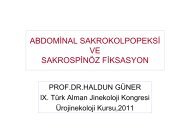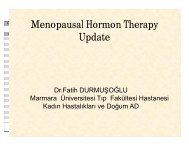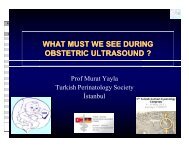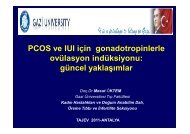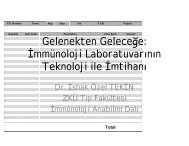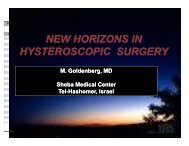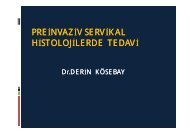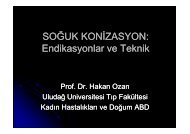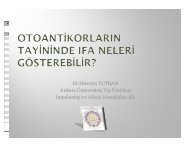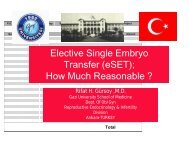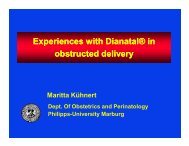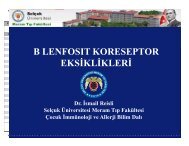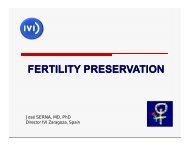Arda Lembet_Array CGH in Prenatal Diagnosis.ppt [Uyumluluk Modu]
Arda Lembet_Array CGH in Prenatal Diagnosis.ppt [Uyumluluk Modu]
Arda Lembet_Array CGH in Prenatal Diagnosis.ppt [Uyumluluk Modu]
Create successful ePaper yourself
Turn your PDF publications into a flip-book with our unique Google optimized e-Paper software.
P.O. Number Terms Rep Ship Via F.O.B. Project<br />
Quantity Item Code Description Price Each Amount<br />
<strong>Array</strong> <strong>CGH</strong><br />
( Comparative Genomic Hybridization ) <strong>in</strong><br />
<strong>Prenatal</strong> <strong>Diagnosis</strong><br />
<strong>Arda</strong> <strong>Lembet</strong>,MD<br />
Associate Professor<br />
Obstetrics and Gynecology<br />
Total
• Postnatal genetic evaluation<br />
–Dysmorphic feautures<br />
–Cognitive difficulties<br />
• <strong>Prenatal</strong> conditions<br />
–Structural anomalies<br />
–Stillborn <strong>in</strong>fants
Basic <strong>in</strong>troduction to arrays<br />
• Metaphase karyotyp<strong>in</strong>g:<br />
–Aneuploidy,deletions,duplications,rearrangements<br />
–5-10 megabases<br />
• Microarray analysis:<br />
–Submicroscopic deletions, duplications<br />
–100 times smaller than ( kilobase range )
Basic <strong>in</strong>troduction to arrays<br />
• Microarray analysis:<br />
– Copy number varitions ( CNV ):<br />
•Regions of DNA larger than a kilobase ( 1000<br />
basepair )<br />
•Autosomes each DNA has 2 copies<br />
•Deletions, duplications, trisomies<br />
•Benign CNVs<br />
•Disease caus<strong>in</strong>g CNVs<br />
•CNVs with unknown significance<br />
•1 Mb
The impact of human copy number variation<br />
on a new era of genetic test<strong>in</strong>g<br />
• Copy number variations ( CNV ):<br />
–Normally found only once on each chromosome<br />
–29,133 CNVs <strong>in</strong> Database of Genomic Variants<br />
–12 % of the human genome is CNV<br />
–CNVs contribute 0.12% -7.3 % of g. variability<br />
–41% of all CNVs overlap with known genes<br />
– www.1000genoems.org<br />
–NAHR , 10 -4 per generation
The impact of human copy number variation<br />
on a new era of genetic test<strong>in</strong>g<br />
• Copy number variations ( CNV ):<br />
• S<strong>in</strong>gle nucleotide polmorphism arrays<br />
– Loss of one allele<br />
– Loss of heterozygosity ( LOH )<br />
– Uniparental disomy<br />
– Non – paternity<br />
– Consangu<strong>in</strong>ity
Basic <strong>in</strong>troduction to arrays<br />
• Microarray analysis:<br />
–Comparative genomic hybridization<br />
•Method: DNA comparison<br />
•Deletions and duplications<br />
•Po<strong>in</strong>t mutaions, balanced translocations, <strong>in</strong>versions can<br />
not be detected<br />
•Microarray analysis technique
<strong>Array</strong> coverage: Density / backbone<br />
• Probes on arrays:<br />
– Oligonucleotides : 30-50 base pair ( bp )<br />
– Bacterial artificial chromosome ( BAC ) :<br />
• 150-750 bp<br />
– S<strong>in</strong>gle nucleotide polymorphisms ( SNP )<br />
– Targeted array<br />
– Whole genome arrays
Comparison of the types of chromosomal abnormalities<br />
that can be detected by karyotype and array <strong>CGH</strong>
Resolution and detection rate of arrays
Construction of a prenatal microarray<br />
• NICHD :Summer 2011, <strong>Prenatal</strong> vs. postnatal<br />
• 5-18 % of children with multipl anomalies<br />
and /or developmental delay and a normal<br />
karyotype will have a disease caus<strong>in</strong>g CNV<br />
• Low density targeted arrays vs / whole<br />
genome arrays
Current <strong>in</strong>dications for microarray<br />
analysis <strong>in</strong> prenatal diagnosis<br />
• Evaluation of ultrasound structural<br />
anomalies<br />
• Del<strong>in</strong>eat<strong>in</strong>g marker chromosomes<br />
• Reciprocal balanced translocations<br />
• Evaluation of stillborn <strong>in</strong>fants
Current <strong>in</strong>dications for microarray<br />
analysis <strong>in</strong> prenatal diagnosis<br />
• Evaluation of ultrasound structural anomalies :<br />
–Fetal samples for standart <strong>in</strong>dications ,<br />
– 5-6 % cl<strong>in</strong>ically significant CNV ,<br />
–When structural anomaly present microarray analysis will<br />
have a detection rate of 1-3 % beyond that of karyotype.<br />
–What is the value if no ultrasound abnomality <br />
–Expert op<strong>in</strong>ion
Current <strong>in</strong>dications for microarray<br />
analysis <strong>in</strong> prenatal diagnosis<br />
• Evaluation of ultrasound structural anomalies :<br />
–Cardiac, CNS, skeletal, urogenital, renal<br />
–Increased NT<br />
–IUGR
• 50 fetuses with major structural anomaly<br />
–Cardiac,CNS,skeletal,urogenital,growth disorder,GI<br />
• Mean GA : 24.5 weeks<br />
• 4 / 50 fetuses had abnormal array<br />
• 1 cl<strong>in</strong>ically significant 2%<br />
• 3 <strong>in</strong>herited benign variants 6%
• 300 samples AS – CVS<br />
• AMA, US abnormality, family history, p. concern<br />
• 58 ( 19.3 % ) CNVs<br />
–40 (13.3 %) Benign<br />
–15 ( 5 % ) Pathological<br />
–3 ( 1 % ) Uncerta<strong>in</strong> cl<strong>in</strong>ical significance<br />
–7 (2.3 %) a <strong>CGH</strong> contributed new <strong>in</strong>formation<br />
–2 ( 1 % ) w/o a <strong>CGH</strong> no abnormality would have<br />
been detected
• NT > 99 th, CVS- normal G band,<br />
• 100 fetuses f/u 22 months<br />
• HR-<strong>CGH</strong> and MLPA<br />
• 80 liveborn<br />
–3 ( 4 % ) had syndromes ( MR,sotos syndrome )<br />
–18 % adverse pregnancy outcome overall<br />
–<strong>CGH</strong> and MLPA did not detect any chromosome abn.with<br />
syndromes
Identification of submicroscopic chromosomal aberrations <strong>in</strong><br />
fetuses with <strong>in</strong>creased NT and an apparently normal karyotype<br />
Leung et al,UOG March 2011<br />
• NT > 3.5 , a<strong>CGH</strong> 44 K oligonucleotide , validation<br />
• CNV 6 / 48 ( 12.5 % ) , 1-7.8 Mb<br />
• 5 / 48 ( 9.5 % ) cl<strong>in</strong>ical significant – validated<br />
• 4 / 48 ( 8.3% ), 1p36 excluded ( normal v )<br />
–Pathogenic CNV 20 % -US abnormality<br />
5.3% -No US abnormality<br />
• Abnormal array, median NT 4.35 mm
Current <strong>in</strong>dications for microarray<br />
analysis <strong>in</strong> prenatal diagnosis<br />
• Evaluation of ultrasound structural<br />
anomalies<br />
• Del<strong>in</strong>eat<strong>in</strong>g marker chromosomes<br />
• Reciprocal balanced translocations<br />
• Evaluation of stillborn <strong>in</strong>fants
Current <strong>in</strong>dications for microarray<br />
analysis <strong>in</strong> prenatal diagnosis<br />
• Del<strong>in</strong>eat<strong>in</strong>g marker chromosomes.<br />
–Nonsatellited markers:15% abnormal phenotype<br />
–Satellited marker risk: 11 %<br />
–Acrocentric chromosome<br />
–Heterochromat<strong>in</strong> vs euchromat<strong>in</strong>
Current <strong>in</strong>dications for microarray<br />
analysis <strong>in</strong> prenatal diagnosis<br />
• Evaluation of ultrasound structural<br />
anomalies<br />
• Del<strong>in</strong>eat<strong>in</strong>g marker chromosomes<br />
• Reciprocal balanced translocations<br />
• Evaluation of stillborn <strong>in</strong>fants
Current <strong>in</strong>dications for microarray<br />
analysis <strong>in</strong> prenatal diagnosis<br />
• Evaluation of ultrasound structural<br />
anomalies<br />
• Del<strong>in</strong>eat<strong>in</strong>g marker chromosomes<br />
• Reciprocal balanced translocations<br />
• Evaluation of stillborn <strong>in</strong>fants
Current <strong>in</strong>dications for microarray<br />
analysis <strong>in</strong> prenatal diagnosis<br />
• Evaluation of stillborn <strong>in</strong>fants :<br />
–5% of structurally normal stillborn fetuses<br />
–35-40 % of structurally abnormal or macerated<br />
•Will have an abnormal karyotype<br />
–Quality of the karyotype
Other potential benefits of microarray<br />
• Turnaround time:<br />
–1-2 weeks for a conventional karyotype<br />
• No need for cell culture<br />
–Sample sites: DNA extraction sites ….<br />
–Also potential benefit for stillbirth
Limitations of microarray<br />
•Balanced translocations will not be detected.<br />
•Standart microarray will not identify<br />
polyploidies .<br />
•Low-level mosaicism :<br />
•Unknown cl<strong>in</strong>ical significance: ISCA-NIH
Current guidel<strong>in</strong>es<br />
• American College Medical Genetics:<br />
– Multiple anomalies not spesific to a well del<strong>in</strong>eated genetic<br />
syndrome, nonsyndromic developmental delay and<br />
<strong>in</strong>tellectual disability and autism spectrum disorders.<br />
– Children with growth retardation, speech delay..etc
Current guidel<strong>in</strong>es<br />
• American College of Obstetrics and<br />
Gynecologists ( ACOG )<br />
–First l<strong>in</strong>e test for prenatal evaluation of chromosomal<br />
abnormalities rema<strong>in</strong>s unknown and convent<strong>in</strong>al<br />
karyotyp<strong>in</strong>g rema<strong>in</strong>s the primary cytogenetic tool.
Current guidel<strong>in</strong>es<br />
• American College of Obstetrics and Gynecologists ( ACOG )<br />
– However, targeted arrays <strong>in</strong> comb<strong>in</strong>ation with genetic counsel<strong>in</strong>g can be<br />
offered <strong>in</strong> the sett<strong>in</strong>g of an abnormal ultrasound f<strong>in</strong>d<strong>in</strong>g and a normal<br />
karyotype result.<br />
– It can also be offered <strong>in</strong> cases of fetal demise with congeital anomalies<br />
when conventional karyotype is unobta<strong>in</strong>able.<br />
– Pretest and posttest genetic counsel<strong>in</strong>g
Future perspectives<br />
•Acceptable cost<br />
–<strong>Array</strong> <strong>CGH</strong>: 442 £ Karyotype: 117 £<br />
–FISH :214 £ MLPA: 245 £<br />
• Fetal cells from various sites<br />
–ECC, fetal cells, cell-free fetal DNA<br />
• S<strong>in</strong>gle nucleotide changes<br />
• Parental orig<strong>in</strong> of del / dup<br />
• Spesific po<strong>in</strong>t mutation analysis
Asphyxiat<strong>in</strong>g Thoracic Dystrophy:<br />
A case report<br />
31 yo<br />
G3P2, alive 0.<br />
Referred due to shortness of long bones.<br />
Gestational age : 14 w 4 d.<br />
No consangu<strong>in</strong>ity.<br />
Family history unremarkable
OB HISTORY<br />
• G 1 was term<strong>in</strong>ated at 24 th weeks.<br />
-USG exam<strong>in</strong>ation:<br />
• Shortness of long bones.( predom<strong>in</strong>atly humerus<br />
and femur. BPD: 24 wk, FL: 17 wk, HL: 18 wk)<br />
• Bow<strong>in</strong>g of humerus and femur<br />
• Narrow thorax<br />
-A/S: normal karyotype
Autopsy:<br />
•Rhizomelia<br />
•Brachydactyly<br />
•Narrow thorax<br />
•Cl<strong>in</strong>odactyly at 5 th f<strong>in</strong>gers
-Radiographic f<strong>in</strong>d<strong>in</strong>gs:<br />
• Bow<strong>in</strong>g at femur and humerus<br />
• Metaphyseal irregularities at all tubuler bones<br />
• Abnormalities at iliac bones. ( square-shaped iliac<br />
bone)<br />
• Short ribs<br />
• Handlebar clavicles<br />
• <strong>Diagnosis</strong>: ATD / Short limb polydactyly related<br />
syndromes
•2nd pregnancy was term<strong>in</strong>ated at 17 th<br />
week .<br />
•-USG:<br />
• Shortness of long bones ( FL
-G3 Current pregnancy USG f<strong>in</strong>d<strong>in</strong>gs:<br />
• Shortness of long bones ( FL, HL< 5 % )<br />
• Bell-shaped thorax<br />
• The other organs and systems were<br />
unremarkable.<br />
Karyotype analysis was normal.
•Molecular karyotype analysis ( cytogenetics<br />
whole genome 2.7 M <strong>Array</strong>)<br />
•Deletion at ACVR1 and ACVR1C genes<br />
located at 2q23-24 region)<br />
–Fibrodysplasia ossificans progressiva
ATD ( Jeune syndrome)<br />
• AR skeletal dysplasia, 1/100,000-1/130,000 live<br />
births<br />
Cl<strong>in</strong>ical and radiological f<strong>in</strong>d<strong>in</strong>gs:<br />
• Bell-shaped / long narrow thorax<br />
• Vary<strong>in</strong>g degree of rhizomelia<br />
• Short hands, polydactyly<br />
• Pelvic abnormalities ( trident acetabulum,<br />
hypoplastic ileum)<br />
• Renal, hepatic, ret<strong>in</strong>al, pancreatic abnormalities
•Most cases of ATD are sporadic, prenatal<br />
diagnosis is very difficult <strong>in</strong> low-risk<br />
women without a previous history<br />
•Cl<strong>in</strong>ical outcome is poor, early prenatal<br />
diagnosis is important. 70% of ATD cases<br />
die <strong>in</strong> early childhood from pulmonary<br />
hypoplasia and respiratory distress<br />
Chen et al. <strong>Prenatal</strong> Diagn 2003; 23
•ATD is known to be genetically<br />
heterogeneous.<br />
•The molecular basis of ATD is unknown,<br />
with few clues to the location of genes<br />
likely to contribute to pathogenesis.( Morgan et al. J<br />
Med Genet 2003.)
•To map a locus for ATD, we performed a<br />
genome wide l<strong>in</strong>kage search
RESULTS<br />
•15q13 region: heterozygote deletion<br />
Morgan et al identified homozygosity for<br />
mutations <strong>in</strong> a specific locus to<br />
chromosome 15q13 <strong>in</strong> five consang<strong>in</strong>eous<br />
families.
• DYNCH2H1 mutations on chromosom 11q. ,<br />
heterozygote deletion.<br />
In a consangu<strong>in</strong>eous family and <strong>in</strong> 2 isolated cases<br />
with short rib-polydactyly syndrome type III<br />
(263510), Merrill et al. (2009) identified<br />
homozygosity or compound heterozygosity for<br />
mutations <strong>in</strong> the DYNC2H1 gene. The<br />
abnormalities <strong>in</strong> short rib-polydactyly syndrome<br />
are primarily related to the effect on the skeleton,<br />
reflect<strong>in</strong>g an essential role for DYNC2H1 <strong>in</strong> cilia<br />
function <strong>in</strong> cartilage.
•We exclude IFT80 mutations.<br />
Mutations <strong>in</strong> the <strong>in</strong>traflagellar transport 80 (<br />
IFT80) gene have been identified <strong>in</strong> 3/ 39<br />
families , ascrib<strong>in</strong>g ATD to the ciliopathy<br />
group.<br />
.<br />
( Beasles et al. Nat. Genet. 2007).
CONCLUSION<br />
• We identified heterozygote mutations at<br />
chromosome 15q13 and 11q (DYNC2H1).<br />
• It is difficult to identify the exact responsibility of<br />
these mutations on the occurence of disease.<br />
• Whether the disease is the consequence of only<br />
one of these two mutations or their comb<strong>in</strong>ed<br />
effect rema<strong>in</strong>s to be determ<strong>in</strong>ed.


![Arda Lembet_Array CGH in Prenatal Diagnosis.ppt [Uyumluluk Modu]](https://img.yumpu.com/32179028/1/500x640/arda-lembet-array-cgh-in-prenatal-diagnosisppt-uyumluluk-modu.jpg)
![Engin Oral_Konjenital uterus anomalileri.ppt [Uyumluluk Modu]](https://img.yumpu.com/51729800/1/190x146/engin-oral-konjenital-uterus-anomalilerippt-uyumluluk-modu.jpg?quality=85)
